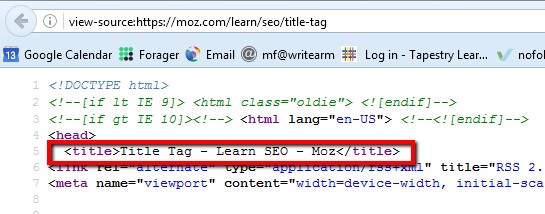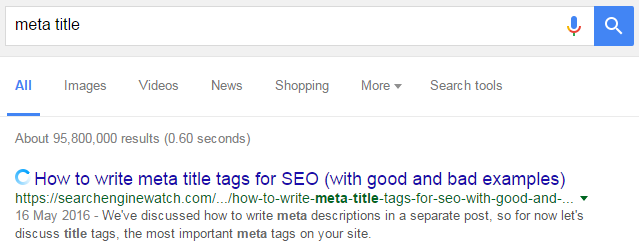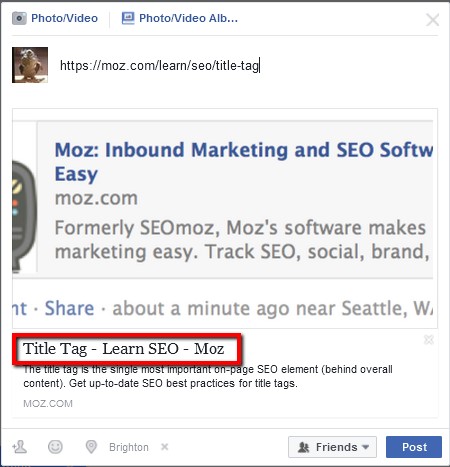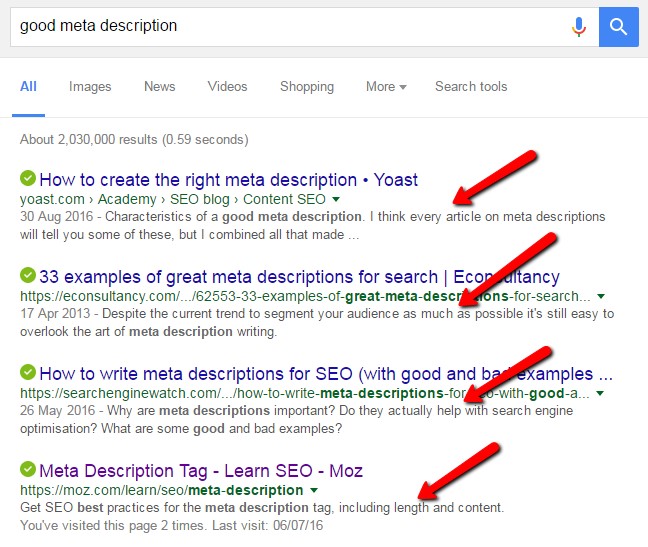Your fast track SEO course continues apace.
In the last post we looked at choosing keywords to target.
And now it’s time to make them work for you. One of the most important ways you can do this is through your meta titles and meta descriptions.
What are meta titles and, more importantly, how do you write ones that do the business?
And while we’re at it what’s a meta description, and how will it help you get those clicks from a results page?
All will be revealed!
On-page SEO: Understanding Meta Titles and Meta Descriptions
Pay attention!
We are about to show you how to use one of the most important on-page ranking factors on your site.
And the beauty of it is that it’s so simple to do.
How to write the perfect meta title
Apart from the actual content on your page the meta title is the most important thing that you can optimise.
So, you’ll be eager to know just how you can make your meta titles perform at their peak, right?
All in good time: let’s first of all explain what a meta title is.
The meta title, sometimes called the title tag or page title, is the part of the HTML code that it is used by search engines to determine the theme of your page.
Of course, the search engines use many other signals to decide on the theme but this is a bit like the judge with the deciding vote.
Let’s take a look at where the meta title appears.
Here it is in the head section of the HTML code of a website:

It also appears here (in blue/purple) in the search results themselves:

And in your browser when you view the page:

And here when you share a page using social media:

Pretty powerful stuff, heh?
Just to drive home how hard that meta title can work for you:
It is not only used by the search engine to decide what to rank you for, it also is a critical factor in convincing people who see your site returned in a search result to click on the link.
The page title is actually your advertising headline for the SERPs.
And that’s why you need to write it with both the search engine and the user in mind.
Search engines like meta titles to be kept short and to the point.
- Google typically displays the first 50-60 characters of a title tag.
Anything longer than that may be truncated, and some SEO experts argue that anything beyond this is also not considered for ranking purposes.
- Google may automatically rewrite your title tag if it is too long or not relevant to the search query.
The best way to avoid this is to make sure your meta title is relevant and the correct length.
Luckily the formula for writing a killer meta tag is simple: this is where SEO truly isn’t rocket science.
(Primary keyword) |
(Secondary keyword or Category for keyword or Location) |
(Brand name/Company name)
Yep, that’s it.
Let’s spell it out (because it is critical that you get this right):
Primary keyword
This is your target keyword. Research suggests that the closer to the front of the meta title this is the more SEO impact it has. That’s why you lead with this rather than your company name.
Secondary keyword
This is one of the keywords related to it that you identified during your keyword research.
Category keyword
If you have a lot of content, or are running an ecommerce site with a lot of products, you may wish to use the category to which your page belongs.
For instance, in a pet supplies shop this may be ‘Dog shampoo | Dog grooming products’.
Location
If location is important to you it can be clearly targeted here.
This is great for Local SEO.
You may have, for example, a meta title of ‘Spanish guitar lessons | Brighton’.
Brand
Our advice is that if you are running short of your allotted characters you drop the brand/company name.
It will be in your URL anyway and, if you are not a known or recognised brand, it matters little (unless your main SEO goal is to raise brand awareness, of course.)
There you have it a simple formula for a very powerful SEO tool.
You can check how your meta titles will look in the search engines here.
And,if our proven meta title formula leaves you uninspired, you can explore some highly creative suggestions here.
The meta title’s sidekick is the meta description – and we’ll turn our attention to this next.
How to write the perfect meta description
First, it’s time to get your hankies out and feel sorry for the poor old meta description.
Sometimes it just doesn’t get the respect it deserves. According to many it has no SEO value whatsoever – but we beg to differ.
While search engines may not use meta descriptions directly to rank they have powerful effects that certainly make a real difference.
And we are going to show you exactly what a meta description is and what we reckon it can do for you.
Then you can decide for yourself whether it deserves pity or respect.
Just like the meta title the meta description is part of the HTML code of your website that appears in the head section of the code for a page (beginning <meta name=).

But, more importantly here are how meta descriptions appear in a SERP:

These examples of meta descriptions have not been chosen at random – we’ll come back to them in a moment.
But first you need a description of a meta description!
Meta descriptions provide concise explanations of what a web page is about. They are commonly used on SERPs to display preview snippets for any given page.
Google has always insisted they are not used directly as part of its ranking algorithm. So, how can a meta description help your SEO?
As part of its ranking factors Google measures clickthroughs from its SERPs. Here’s a SERP result – take a look and see what little there is, apart from your position on the page, to influence clickthrough.

There’s nothing there but a meta title, a URL and a meta description.
Look again at that search result and you’ll see that it is the meta description that really gives you the chance to sell your content and win those clicks. And this is how your meta descriptions can boost your SEO.
Any result getting more clicks than those with a higher position is very likely to be reviewed by Google – this could represent your chance to improve your page position, say from position five to position two, which is the difference between an expected 6% of the clicks to an expected 14%.
Meta descriptions can be your fast track ticket to traffic heaven.
And here’s what you need to do.
The first rule here is make it unique
You need a unique meta description for every page of your site. Far too many websites simply write one and then use it for every page they have.
This will not encourage clickthrough from a SERP as it is not relevant to a specific search query.
But it is also likely to be ignored by Google, which will, in its infinite wisdom, decide to simply pull bits of text from your page that it thinks are relevant.
Like this genuine example:
“A little over a month ago, Google announced a new rich snippet … In fact, searching for [islamic prayer pomona] and [jewish prayer times …”

The second rule is make sure every page has one
As we’ve seen, if you don’t you will have to let Google pluck seemingly random bits of text from your page.
The third rule is keep it brief – you have just 155 characters to make it count
Anything over this will be truncated or the description ignored in favour of that darned seemingly random text pull again.
The fourth, and final rule, is to treat it like an advert
Sell the benefits not the features. In other words, don’t just say what your company does, explain how it can help the person who is doing the searching. This is your chance to get those clicks from a search page and in doing so improve your SEO. To do this your description should include:
- Your target keywords (and Google will bold them when they match a search query).
- A strong call to action.
- A clear description of what the page is about and, more importantly, what questions it answers.
Returning to the example descriptions we looked at above is a good way to see good and bad practice (from people who should know better).
Here were the results from a search query for a ‘good meta description’.

The first two appear to use the opening sentence of the webpage in question. They are not bad, after all opening sentences tend to be written to intrigue, entice and summarise the topic covered.
But compare them to the two killer meta descriptions that follow:
“Why are meta descriptions important? Do they actually help with search engine optimisation? What are some good and bad examples?”
Pretty good, eh? Check this out, though, for a truly brief and highly effective meta description:
“Get SEO best practices for the meta description tag, including length and content.”
It tells you what you get (‘SEO best practices’), mentions the topic (‘meta description tag’) and informs you what it covers (‘including length and content’).
That gets our vote and it would get our click. And that’s exactly how meta descriptions can make or break your SEO.
All the posts in this series can be found here.
For the complete version of this Fast track SEO course head over to Amazon.
It’s yours for less than a fiver!

